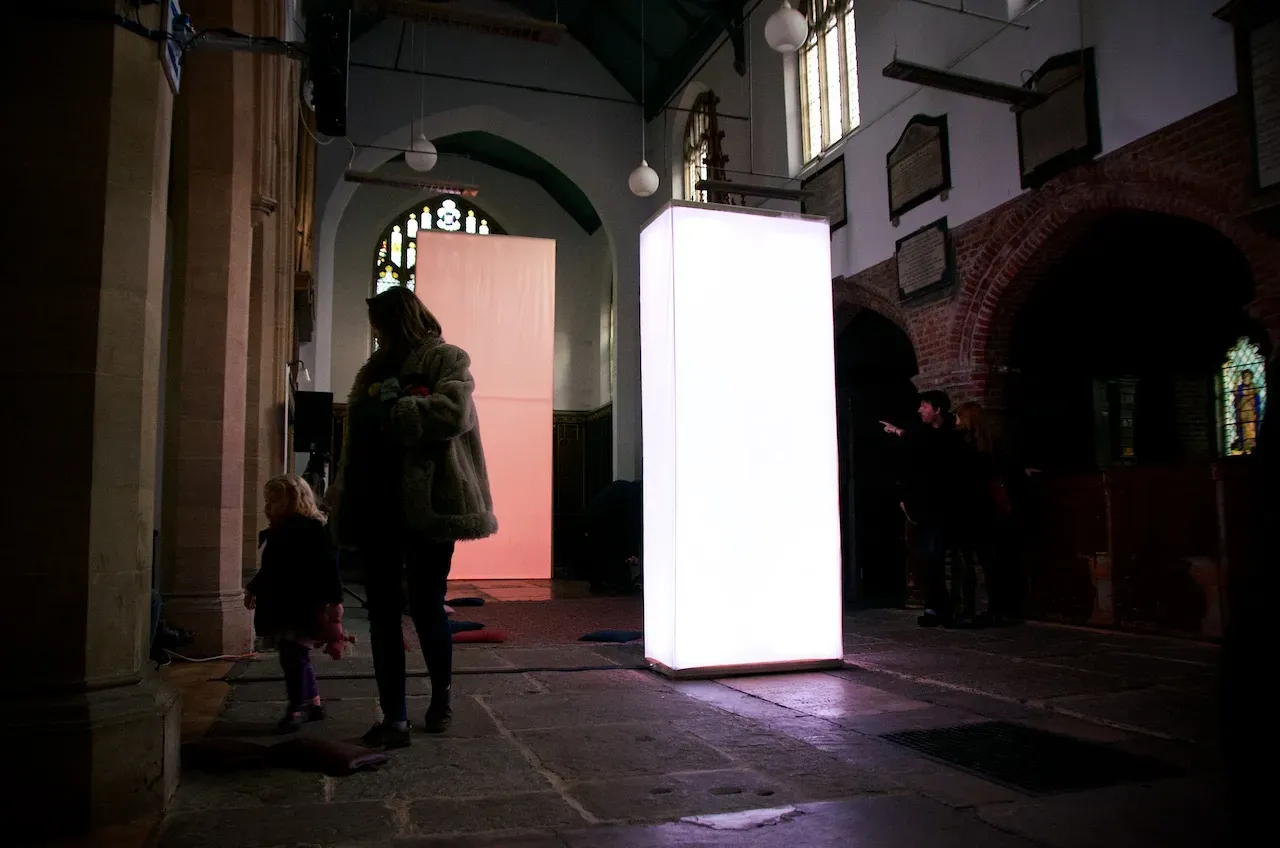Resonant Frequencies

Our wind harp installation VOX uses strings that are tuned to the resonant frequencies of the space that contains the (audiovisual part of the) installation: the only surviving Elizabethan church in London, The Old Church arts venue. Probably the commonest question that we have been asked is not how we made it, but what does it actually mean to say that it is tuned to the resonant frequencies of the space and how does one know what those are?
For the first part of this question, what it means is that the sounds we play will reverberate within the church such that they appear to fill the space. This is because the sounds you hear literally do fill the space. Sounds bounce off walls: one can hear this obviously in the echo of a very large space, but to a lesser extent one can detect it in any mostly empty space – it’s why new houses sound so weirdly empty. With a continuous sound, you mostly don’t notice the echo because the original source is louder. However, if you get the frequency of the sound right, the echoes reinforce the original sound so that the sound ceases to come from one spot and instead comes from everywhere.
It’s easiest to work out why if you think of sound waves as being like waves on the surface of water. (In fact they are really not like that at all as they are actually rapidly moving regions of air compression and expansion, but that’s much harder to visualise.) These waves have a wavelength that is inversely proportional to their frequency, i.e., the higher the frequency, the shorter the wavelength. Each wave consists of a region of water that has moved up and a similar region of water that has moved down, the wavefront moves as the water ahead rises and the water behind falls into the dip and then rises back to being level again. A continuous sound is just a continuous series of waves, one behind the other.
When one of these waves hits a wall, it reverses direction. Mostly what then happens is that the rising and falling regions of the bouncing waves interfere with the rising and falling regions of the incoming waves. This interference causes the waves to become less clearly distinguished and eventually results in them dissipating. But if the wave bounces back such that the rising part exactly matches the rising part of the incoming waves, then instead of interfering with the incoming waves it adds to them, causing the waves to become larger. The easiest way to see this at work is to move your hand up and down in a tub of water; if you start slowly and increase the speed of the movements you will notice a moment when the entire contents suddenly begins to slosh violently and spill out (a favourite but messy bath-time game for children). This is the point at which you have hit a resonant frequency of the water in the tub.
I say a resonant frequency because any space will have more than one. Most simply this is because waves can bounce along different paths, but also because there are multiple wavelengths that will resonate along the same path. This leads us on to the second part of the original question: how does one know what the resonant frequencies are? The answer is that the resonant frequencies are the ones with wavelengths that fit an exact number of times along the path. So if we imagine the length of the church, the first resonant frequency along that path is the one where a single wave fits exactly along that distance; the second frequency is double that, with exactly two waves fitting in the same distance; and so on. Each of these higher frequencies (shorter wavelengths) is called a harmonic frequency of the lowest (longest).
The waves one gets when hitting these resonant frequencies are called standing waves. The interesting thing about them is that one gets areas where that sound is very loud and points in-between these of near complete silence. It’s the same phenomenon as you might have seen kids achieving with a long skipping rope, when one manages to get it to spin such that two skipping “zones” appear with the centre point completely still – as if an invisible person was holding it in the middle. Thus hitting the resonant frequencies of a space leads to a particularly interesting experience where different tones come to the fore as one moves around the space.
One might imagine that I used special equipment to calculate these frequencies, but in fact I did it by literally measuring the space: while we cannot see how long a sound wave is, we can calculate it fairly easily knowing the speed of sound in air (around 340m/s, but varying depending on temperature and pressure). Thus one can work backwards from a particular length to figure out what frequency has that exact wavelength, and then all of the harmonics are simple multiples of that frequency. In the case of The Old Church, the length of the church works out at about 16Hz and the width at about 25Hz and so these are the tunings we chose for the first two strings.
I’ll let you into a secret: the third string, which is tuned to 29Hz, wasn’t chosen to match a resonant frequency; it was chosen based on the aesthetics of the combination. One would have imagined that the height of the church would be the obvious third frequency, but the arched roof complicates this. Also, a standing wave along the height of the space could only be experienced by moving up and down, which is tricky to achieve without a long step-ladder! I don’t mind because, in the end (and despite this article), the piece is an artwork to be enjoyed, not a maths lesson.
